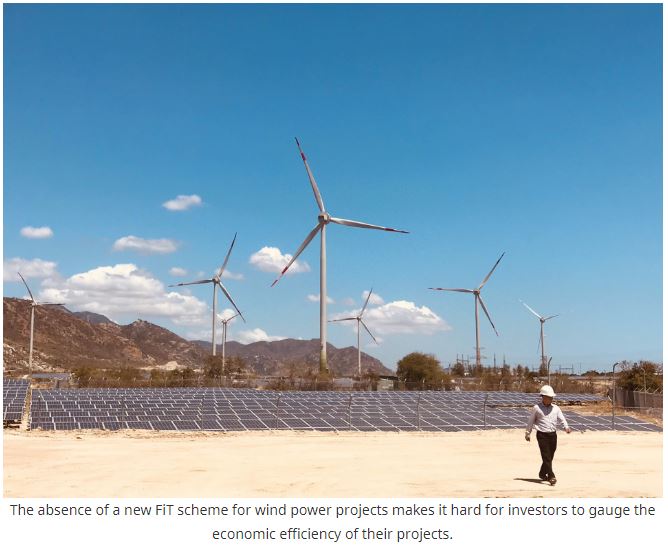Vietnam to become green manufacturing hub by 2050 through net zero approach
Vietnam’s commitment to achieving net zero emissions by 2050 at COP26 is expected to bring a tailwind of opportunities, facilitating the export of made-in-Vietnam products.
Towards this goal, Vietnam would need to change its mindset from how to efficiently use energy for production, to what is the efficient way to create products.
Nguyen The Chinh, deputy chairman of the Vietnam Association for Environmental Economics (VIASEE) and director of the Environmental Economic Policy Institute (EEPI), noted that Prime Minister Pham Minh Chinh’s commitment at COP26 marks an important watershed in realising the target of restructuring Vietnam’s economy towards low-carbon emission and green development model.
Mark Hutchinson, chairman of the Southeast Asia Working Group of the Global Wind Energy Council (GWEC), said to achieve the net zero commitment by 2050, a combination of renewable energy development and fossil fuel elimination is required, along with increasing reserve flows to balance the grid and eliminate carbon out of the atmosphere.
Many global groups with factories in Vietnam are shifting to using cleaner sources of energy. That is why Vietnam’s Ministry of Industry and Trade (MoIT), with support from the US Agency for International Development, now engages in crafting a Direct Power Purchase Agreement (DPPA) mechanism for the deployment between power consumers and renewable energy power distributors, striving for completion in the forthcoming time.
Many global players setting up shop in Vietnam are yearning for the mechanism to soon be in place, allowing them to export products to more developed markets.
Samsung Vietnam had once asked the MoIT to support the company with a trial implementation of a DPPA scheme.
Back in December 2020, a group of 29 global brands sent a letter to Vietnam’s head of government, calling to deploy the DPPA scheme between buyers and sellers of renewable energy sources, thus paving the way for these global brands to finalise their emission targets.
Noel Kinder, chief sustainability officer at sportswear giant Nike noted, “By 2030, our commitment is to reduce greenhouse gas emissions by 65 per cent in our owned or operated spaces, and by 30 per cent across our extended supply chain.”
Achieving net zero with clean energy development
To reach the target and limit global warming, experts agree that it is essential for the globe to take strong measures and have suitable policies in place to drive energy transition, striving for the total elimination of fossil fuel and shifting towards using eco-friendly renewable energy sources.
Therefore, right after returning home from COP26, the prime minister requested the MoIT to revise the latest Power Development Plan (PDP 8) towards promoting green energy, particularly wind power.
The leader of Trung Nam Group, one of the largest companies in the renewable energy sector in Vietnam, said that as a private investor in the energy sector Trung Nam is well aware and highly appreciates the role and significance of renewable energy, which is deemed an inevitable trend of the energy sector on the global scale.
From the company’s perspective, wind power development is attuned to the global endeavour and Vietnam’s energy development orientation under Resolution No.55-NQ/TW from 2020 as well as its commitment to net zero emissions at COP26.
According to Hutchinson, to achieve net zero by 2050, renewable energy needs to be strongly developed. To meet this demand, the government is continuing to review and perfect the draft PDP 8 to significantly increase the share of renewable energy.
Offshore wind power is one of the important renewable energy sources to help Vietnam achieve its net zero commitment by 2050. With high load hours and dwindling costs, it is considered one of the few technologies that can effectively replace coal power.
Vietnam’s wind power potential is huge, providing prerequisites for bolstered development of wind power projects in the upcoming time amid abating investment cost of wind power projects.
Studies show that during 2010-2020, the investment ratio of solar power and battery projects shed an average of 14 per cent a year against a 5-per-cent reduction of wind power investment and is expected to further go down during 2020-2040.
As the feed-in-tariff (FiT) for wind power projects had expired last October, a new policy and mechanism are urgently needed with clear criteria and high feasibility.
The FiT scheme for solar power projects was finalised in late 2020, but since then no new mechanism has been introduced. Despite having support from the World Bank and the Asian Development Bank, Vietnam has yet to enact a bidding mechanism for renewable power projects.
This makes it quite difficult for investors to gauge the economic efficiency of their projects, leading to a standstill in wind power investment in the forthcoming time amid the absence of clear policies and a failure to balance the state-investor and power consumer benefits with suitable risk-sharing mechanisms.
Nguyen Van Vy, deputy chairman of the Vietnam Energy Association, suggested that for sizable wind power projects, the investors should be allowed to prepare their projects and negotiate with the power management authority a power selling price.
Source: VIR


 English
English




